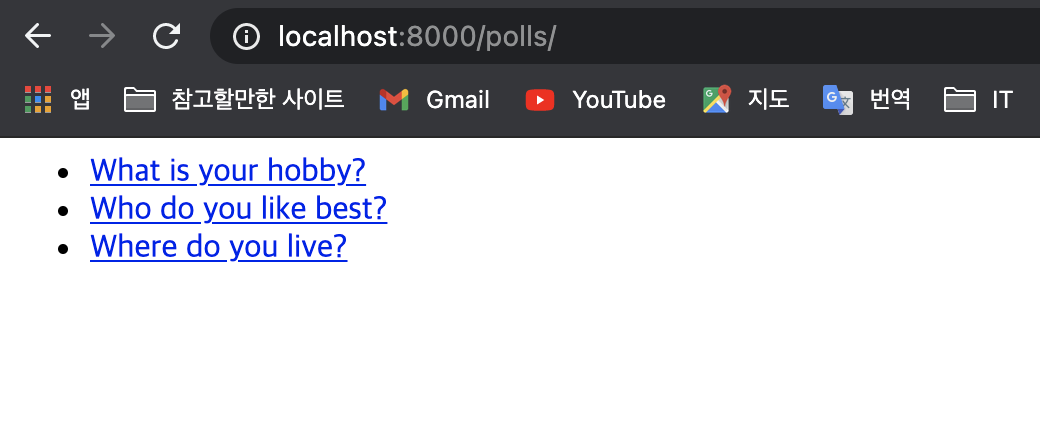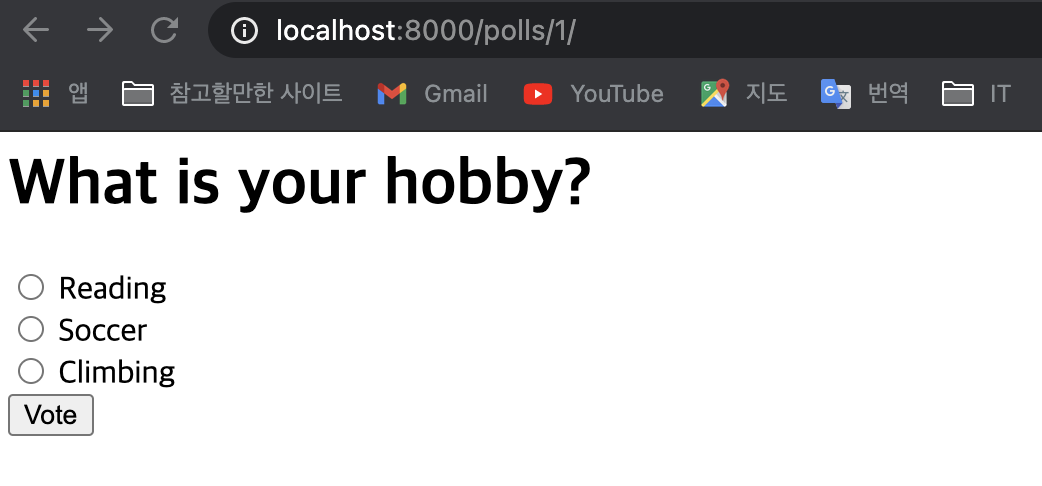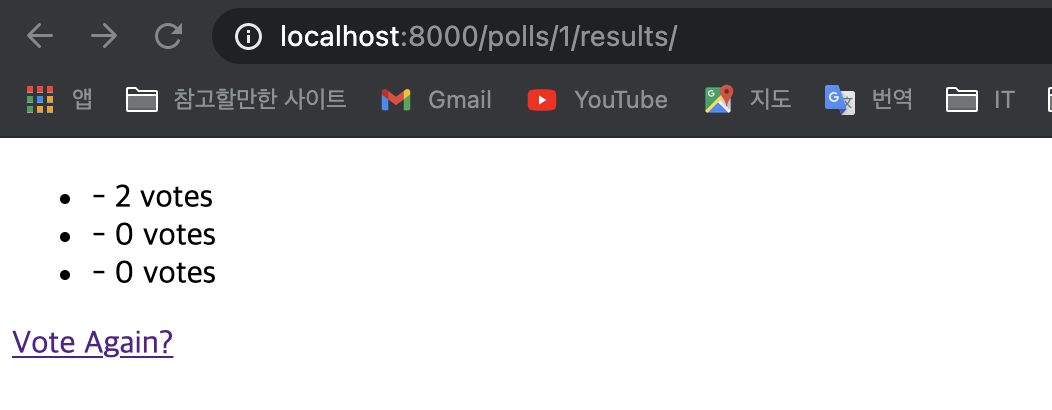애플리케이션 개발하기 - URLconf, View 및 Templete 코딩
ch3/mysite/urls.py 파일에 정의
1. 처리 흐름 설계
| URL 패턴 | View 이름 | Templete 이름 |
|---|---|---|
| /polls/ | index() | index.html |
| /polls/5/ | detail() | detail.html |
| /polls/5/vote/ | vote() | REDIRECT:/polls/5/result |
| /polls/5/results/ | results() | results.html |
2. 작업 순서
URLconf -> templete or view
- urls.py 작성
- views.index(), index.html 작성
- views.detail(), detail.html 작성
- views.vote() 작성
- views.results(), results.html 작성
3. URLconf 코딩
admin 사이트를 포함하여 5개의 url 가 필요함. ch3/mysite/urls.py 에 코딩
- mysite/settings.py 파일의 ROOT_URLCONF 항목이 정의되어 있으며, 이 항목에 정의된 urls.py 파일을 가장 먼저 분석함
- 지금처럼 mysite/urls.py 에 polls에 대한 urlconf를 작성할 수도 있고, mysite/urls.py와 polls/urls.py에 나누어서 작성 할 수도 있음
- 파일을 나누어 작성하는 방법을 추천함, 예시 2 (계층적인 구조로 유지보수에 좋음)
-
예시 1 (mysite/urls.py 에 한번에 작성하는 방법)
- mysite/urls.py
from django.contrib import admin from django.urls import path from polls import views # URL 패턴 매칭이 위에서 아래로 진행되므로, 순서에 유의 해야 함 # path() 함수는, route, view 2개의 필수 인자와 kwargs, name 2개의 선택 인자를 받음 # route: URL 스트링 # view: 호출되는 뷰 함수 # kwargs: URL에서 추출된 파라미터 외에 추가적인 파라미터를 함수에 전달 할때 사용 # name: 각 URL 패턴별로 이름을 붙여줌. 이 이름을 Templete 에서 많이 사용함. urlpatterns = [ path('admin/', admin.site.urls), path('polls/', views.index, name='index'), path('polls/<int:question_id>/', views.detail, name='detail'), path('polls/<int:question_id>/vote/',views.vote, name='vote'), path('polls/<int:question_id>/results/',views.results, name='results'), ] -
예시 2 (mysite/urls.py와 polls/urls.py에 나누어서 작성하는 방법)
- mysite/urls.py
from django.contrib import admin from django.urls import path, include import polls urlpatterns = [ path('admin/', admin.site.urls), path('polls/',include('polls.urls')), ]- polls/urls.py
from django.urls import path from . import views # URL 패턴 매칭이 위에서 아래로 진행되므로, 순서에 유의 해야 함 # path() 함수는, route, view 2개의 필수 인자와 kwargs, name 2개의 선택 인자를 받음 # route: URL 스트링 # view: 호출되는 뷰 함수 # kwargs: URL에서 추출된 파라미터 외에 추가적인 파라미터를 함수에 전달 할때 사용 # name: 각 URL 패턴별로 이름을 붙여줌. 이 이름을 Templete 에서 많이 사용함. # app_name 은, URL가 중복되는 경우 네임스페이스를 구별해 줌 (예를 들어, polls 애플리케이션과 임의의 blogs 라는 애플리케이션이 'detail' 이라는 url 패턴을 갖는 경우,) app_name = 'polls' urlpatterns = [ path('', views.index, name='index'), # /polls/ path('<int:question_id>/', views.detail, name='detail'), # /polls/5/ path('<int:question_id>/vote/',views.vote, name='vote'), # /polls/5/vote/ path('<int:question_id>/results/',views.results, name='results'), # /polls/5/results ]
4. 뷰 함수 index() 및 템플릿 작성
(1) 템플릿파일을 생성할 디렉토리 생성
- 템플릿 디렉토리 생성
~polls>mkdir templates
# templates안에 또 polls 디렉토리를 생성하여 그 하위에 템플릿 파일을 저장하는 이유는, 이름이 같은 템플릿 파일들의 충돌을 막기 위함
~polls>mkdir templates/polls
- settings.py 파일 TEMPLATES 항목의 DIRS에 템플릿 디렉토리 경로 지정
# mysite/settings.py
(생략)
TEMPLATES = [
{
'BACKEND': 'django.template.backends.django.DjangoTemplates',
'DIRS': [os.path.join(BASE_DIR,'templates')],
'APP_DIRS': True,
'OPTIONS': {
'context_processors': [
'django.template.context_processors.debug',
'django.template.context_processors.request',
'django.contrib.auth.context_processors.auth',
'django.contrib.messages.context_processors.messages',
],
},
},
]
(생략)
(2) index.html 템플릿 파일 생성
<!DOCTYPE html>
<html lang="en">
<head>
<meta charset="UTF-8">
<title>Title</title>
</head>
<body>
<p>No polls are available.</p>
</body>
</html>
(3) index() 뷰 함수 생성
polls/views.py 파일에 함수 정의
from django.shortcuts import render
from polls.models import Question
# Create your views here.
def index(request):
# Question 테이블 객체에서 pub_date 컬럼의 역순으로 정렬하여 5개의 최근 Question 객체를 가져옴
latest_question_list = Question.objects.all().order_by('-pub_date')[:5]
context = {'latest_question_list':latest_question_list}
# render() 는 context를 인자로 받아 HTTPResponse를 반환함
return render(request, 'polls/index.html', context)
- 단축함수란?
- 템플릿 변수를 로딩한 후에 컨텍스트 변수를 적용하고, 그 결과를 HTTPResponse 객체에 담아 반환하는 작업등의 공통 기능들을 장고에서 미리 만들어 내장함수로 제공하는 함수.
- 예를 들어, render() 함수
5. 뷰 함수 detail() 및 폼 템플릿 작성
(1) detail.html 템플릿 작성
<!DOCTYPE html>
<html lang="en">
<head>
<meta charset="UTF-8">
<title>Title</title>
</head>
<body>
<h1>{{ question.question_text }}</h1>
{% if error_message %}<p><strong>{{ error_message }}</strong></p>{% endif %}
<!-- url 탬플릿 태그 사용, polls:vote는 URLconf 에서 적은 url 패턴 이름 -->
<form action="{% url 'polls:vote' question.id %}" method="post">
<!--폼을 처리하는 경우, CSRF 공격을 방지하기 위한 기능-->
{%csrf_token%}
<!--vote() 뷰 함수에서 request.POST['choice'] 구문으로 액세스 할 수 있음-->
<!--input 태그의 name, id 속성은 request.POST 사전에서 key, value 로 상돋됨-->
{% for choice in question.choice_set.all %}
<input type="radio" name="choice" id="choice{{ forloop.counter }}" value="{{ choice.id }}"/>
<label for="choice{{ forloop.counter }}">{{choice.choice_text}}</label><br/>
{% endfor %}
<input type="submit" value = "Vote" />
</form>
</body>
</html>
- choice_set 속성 : Question:Choice 의 관계가 1:N 으로, 이런 관계일 때 XXX_set 이라는 속성을 기본적으로 제공함
(2) detail() 뷰 함수 작성
from django.shortcuts import render, get_object_or_404
from polls.models import Question
# Create your views here.
# def index(request):(생략)
def detail(request, question_id):
question = get_object_or_404(Question, pk=question_id)
return render(request, 'polls/detail.html', {'question':question})
- 단축함수
get_object_or_404: 첫번째 인자는 모델 클래스, 두번째 인자부터 조건. 조건에 맞는 객체를 조회하고, 없으면 404 에러를 반환. ‘get_list_or_404()' 함수도 있음
6. 뷰 함수 vote() 및 리다이렉션 작성
detail.html 로 부터 /polls/5/vote url로 POST 방식으로 전달됨
detail.html :<form action="{% url 'polls:vote' question.id %}" method='POST'>
urls.py :path('polls/<int:question_id>/vote/', views.vote, name='vote' )
(1) vote() 뷰 함수 작성하고 Redirect 하기
from django.shortcuts import render, get_object_or_404
from polls.models import Question, Choice
from django.http import HttpResponseRedirect
from django.urls import reverse
# Create your views here.
# def index(request): (생략)
# def detail(request, question_id):(생략)
def vote(request, question_id):
question = get_object_or_404(Question, pk=question_id)
try:
selected_choice = question.choice_set.get(pk=request.POST['choice'])
except (KeyError, Choice.DoesNotExist):
# 설문 투표 폼을 다시 보여준다
return render(request, 'polls/detail.html', {'question':question, 'error_message':"You didn't select a choice."})
else:
selected_choice.votes +=1
selected_choice.save()
# POST 데이터를 정상적으로 처리하였으면,
# 항상 HttpResponseRedirect를 반환하여 리다리엑션 처리함
return HttpResponseRedirect(reverse('polls:results', args=(question_id,)))
- redirect : django.http.HttpResponseRedirect 함수 사용.
- KeyError : request.POST[‘choice'] 의 choice 라는 키가 없을 때 발생하는 에러
- Choice.DoesNotExist : 검색 조건에 맞는 Choice 객체가 없을 때 발생하는 에러
reverse(): 보통 URL 패턴의 URL 스트링으로 부터 url 검색을 시작하는데, reverse() 함수는 URL 패턴 이름으로 URL 스트링을 찾아가도록 하는 함수.- 소스에 URL 스트링을 하드코딩 하지 말고 reverse() 함수를 사용하도록 함
7. 뷰 함수 results() 와 템플릿 작성
(1) results() 뷰 함수 작성
def results(request, question_id):
question = get_object_or_404(Question, pk=question_id)
return render(request, 'polls/results.html', {'question':question})
(2) results.html 탬플릿 작성
<!DOCTYPE html>
<html lang="en">
<head>
<meta charset="UTF-8">
<title>Title</title>
</head>
<body>
<h1>{{ quesiton.question_text }}</h1>
<ul>
{% for choice in question.choice_set.all %}
<li>{{choice.text}} - {{choice.votes}} vote{{choice.votes|pluralize}}</li>
{% endfor %}
</ul>
<a href="{% url 'polls:detail' question.id %}">Vote Again?</a>
</body>
</html>
vote: choice.votes 값에 따라 복수로 표현할지를 결정 하는 pluralize 탬플릿 필터, 결과적으로 ‘vote' 또는 ‘votes'로 보여짐
8. 지금까지 작업 확인하기
-
테스트서버 실행
$ch3>python manage.py runserver - 웹 브라우저에서 ‘http://localhost:8000/polls' 실행
- 현재 데이터가 하나도 없어서 빈 페이지로 나타남

- 현재 데이터가 하나도 없어서 빈 페이지로 나타남
- Admin 사이트(http://localhost:8000/admin)로 로그인 하여, Question, Choice 테이블에 데이터 입력
- Questions 테이블
question_text Date Time What is your hobby? today now What do you like best? today now Where do you live? today now - Choices ( 나머지 question_text에도 3개 정도의 choice_text를 임의로 등록해 보자.)
question_text choice_text vote What is your hobby? Reading 0 What is your hobby? Soccer 0 What is your hobby? Climbing 0 - 웹 브라우저에서 ‘http://localhost:8000/polls' 실행
- Question 목록이 보여짐

- Question 목록이 보여짐
- ‘What is your hobby?' 를 클릭하여, ‘http://localhost:8000/polls/1/' 실행
- choice 목록이 보여짐

- choice 목록이 보여짐
- ‘Reading'에 체크하고 ‘vote' 버튼 클릭하여 ‘http://localhost:8000/1/vote/' 실행 -> ‘http://localhost:8000/1/results' 로 redirect 됨
- choice의 투표 결과가 보여지는 result.html 화면이 보여짐

- choice의 투표 결과가 보여지는 result.html 화면이 보여짐